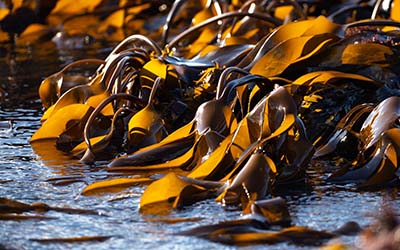You are here
- Home
- Research & Innovation
- Knowledge exchange
- Engaging with policymakers
- Sustainable seaweed
Sustainable seaweed
Seaweed in Scotland
Scotland’s coastlines provide a thriving environment for kelp forests. These are important in the coastal ecosystem and for helping to tackle climate change: providing nursery grounds for fish on all foodchain levels, and supporting the offset of carbon emissions.
Seaweed has historically been used for products as diverse as fertiliser, food and medicine, and more recently, as natural products and biofuel.
Industrial activity around seaweed is increasing, with the establishment of seaweed farms and development of new cultivars and technologies.
The multi-faceted uses of seaweed in Scotland and the ways in which it can make the country's future economy more secure, sustainable and inclusive are explored in an Innogen Institute project by the OU and The University of Edinburgh.
The Choreographies of Scottish Seaweed Research and Development Project also aims to understand the historic and cultural role of seaweed.
It maps relevant actors, establishes how seaweed has developed over time, and examines emergent scientific and industrial activities that are successfully combining a healthy, profitable competitive market with optimal environmental preservation.
Research covering marine economy involves a variety of organisations and stakeholders, often with different goals which are interconnected but not always aligned, making it even more relevant to address in light of the current climate emergency.
Key project focuses
The project’s three main aspects are:
The policies and politics of seaweed
- A review of current Scottish policy related to research and economic generation, being propelled by (inter)national efforts to solve climate change challenges, and potential environmental impacts
- Coastal communities' challenges and the building of their resilience in a changing environment, including economic dimensions triggered by the Covid-19 pandemic, such as reduced tourism income, and job loss
 Mapping Scottish seaweed research and development
Mapping Scottish seaweed research and development
- Understanding the relationship between research and innovation actors working on seaweed, through the mapping of relevant actors, publications and products onto existing maps of seaweed species in Scotland
- Emphasising the diverse research ecology, as well as established and emerging industries such as cosmetics, spirits, and seaweed supplements.
Algal cultures
- Exploration of the historic uses of seaweed in local coastal communities and its roles in artisan and artistic practice
- Contemporary artistic engagement in relation to seaweed and specific communities, such as the marine botanical works of artist and environmentalist Lottie Goodlet on Argyll.
Recommendations
A final report will outline key messages on how the Scottish marine research community can think innovatively about the ways in which community engagement is being carried out.
It will also focus on how policymakers can better drive public interest, and support businesses associated with the seaweed industry. Transferable skills will be identified, that can help implement new policies and regulations in a realistic manner, making the agenda integrative, inclusive and resilient.
Contact us
To explore working together to support your aspirations please contact:
Derek Goldman, Knowledge Exchange Manager
derek.goldman@open.ac.uk